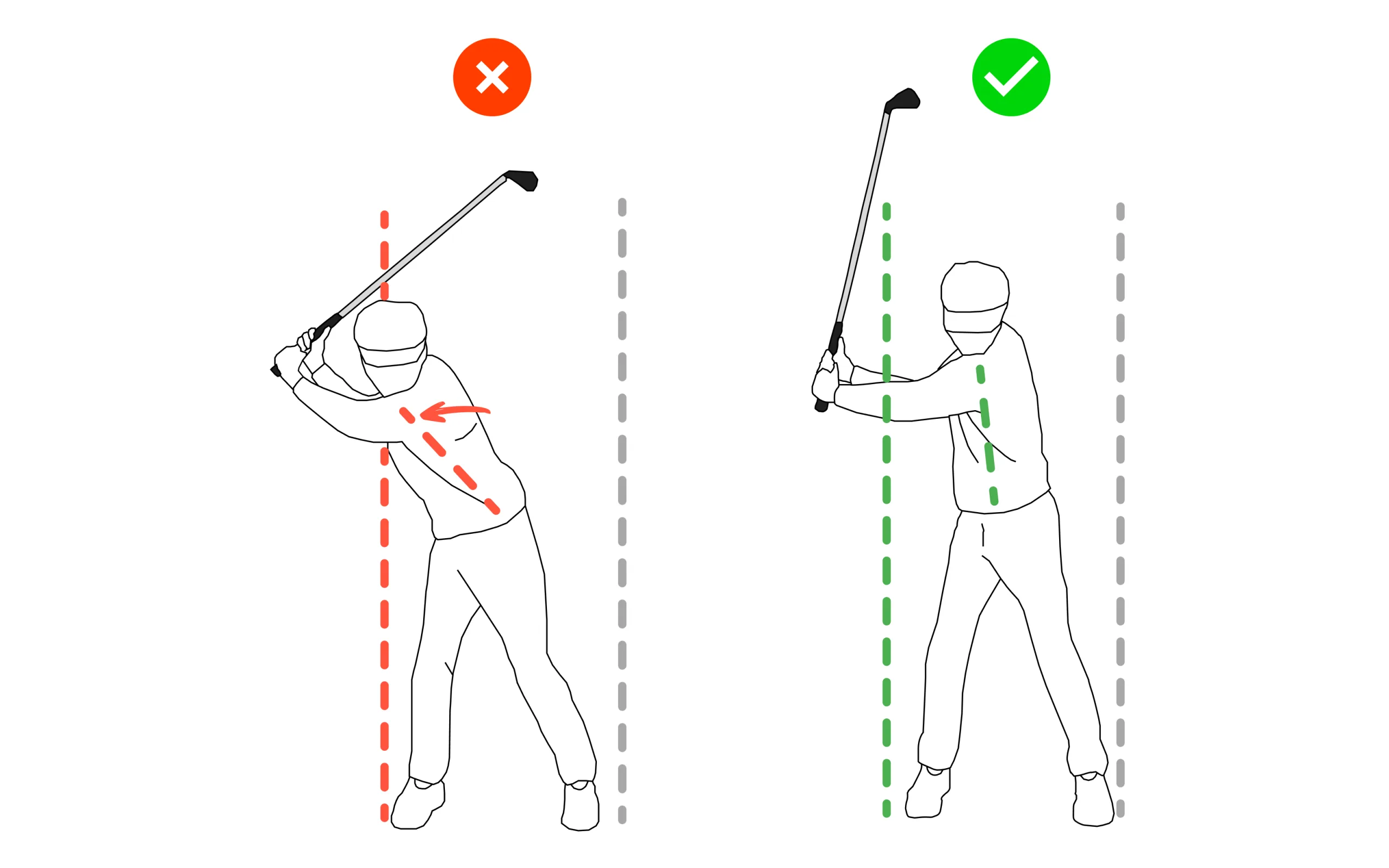
“Upper body sway” in golf refers to an excessive lateral movement of the upper body during the swing, typically away from the target line, causing the golfer’s weight to shift off the ball and potentially impacting swing consistency and accuracy
Alternate Names
- Sway Gap
- Sideways Motion of Upper Body
Causes of Upper Body Sway in Backswing
Golf Technique DeficiencyImproper weight transfer: The weight should be shifted gradually and smoothly from the back foot to the front foot.
Poor wrist mechanics: Proper wrist positioning can help with stability and control.
Overactive lower body: The upper body should be the primary source of power, not the lower body.
Drills to Fix the Issue
Headcover Under Foot Drill
Trains proper weight loading into the trail side while preventing upper body sway.
- Place a headcover under the heel of your trail foot.
- Set up in your normal golf stance.
- Begin a slow, controlled backswing.
- Focus on pressing down into the headcover during the backswing.
- Keep your upper body stable — avoid swaying or shifting laterally.
- Repeat to reinforce proper weight distribution and centered rotation.
🎯 Goal: Promote solid trail-side loading and eliminate upper body sway during the backswing.
Swiss Ball Hip Stability Drill
Builds hip control and eliminates lateral sway during the backswing and transition.
- Stand in your normal stance with your lead hip lightly touching a Swiss ball.
- The Swiss ball should be supported by a chair to keep it in place.
- Begin your backswing while keeping your lead hip in contact with the ball.
- Maintain that contact throughout the swing — avoid drifting away.
- The ball should only drop after your swing is complete and you’re standing upright.
- Repeat to develop the feel of stable, centered hip movement.
🎯 Goal: Train consistent hip stability and minimize sway for a more controlled, balanced swing.
Target Line Pressure Drill
Trains proper hand path and resistance awareness during the takeaway.
- Set up in your normal golf stance.
- Hold the club with your trail hand vertically (perpendicular to the ground).
- Begin a slow backswing while gently pressing the club into the ground.
- As you apply pressure, guide the club along the target line — not behind you.
- Focus on feeling resistance and keeping the motion connected to your body.
- Repeat to groove a proper takeaway path and prevent early club retraction.
🎯 Goal: Train efficient hip rotation and proper weight shift without early slide or sway.
Lawnmower Drill
Train upper body rotation and prevent lateral sway during backswing.
- Stand in your golf stance, no club needed.
- Let your trail hand hang in front of your trail knee.
- Mimic starting a lawnmower — pull your trail hand diagonally up and back toward your trail hip.
- As you pull, rotate your torso (shoulders and chest) around your spine.
- Keep your head steady and avoid leaning sideways.
🎯 Goal: Build the feel of rotating the upper body without swaying laterally. This encourages a coiled, stable backswing and better ball-striking.
Physical Limitations
Limited ankle pronation – If the trail side ankle can’t pronate or evert, it can be difficult to keep weight on the inside of the back foot.
Lack of Lower Body Stability – A lack of stability and strength in the lower body can cause the upper body to swing.
Tight Hip Flexors or Poor Hip Mobility – When the body can’t rotate around the trail hip, lateral movement will occur. This is often due to joint or muscle restrictions.
Lack of core stability: Core strength training can help with stability and control.
90/90 Hip Rotations – Improves rotational range in the hips.
Dead Bug with Core Activation – Builds deep core control and anti-sway resistance.
Open Books (Thoracic Rotations) – Increases spine flexibility for better shoulder turn.
How to Adapt Your Swing to Physical Limitations
- Use a shorter backswing to stay within your body’s rotation range.
- Widen your stance for more balance and to discourage lateral movement.
- Slightly flare your trail foot to allow easier trail hip rotation.
Related Swing Errors
Precursor Errors (Triggering Issues)- Poor Setup/Posture
- Over-bending at the knees
- Reverse Spine Angle
- Over-the-Top Swing Path
Tools and Training Aids
- Wall or Chair Behind Hips – Provides tactile feedback to detect sway.
- Resistance Bands Around Hips – Trains proper coil without lateral movement.
- Swing Mirror or Video Feedback – Helps visualize whether the chest is turning or sliding.
